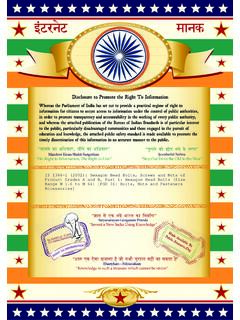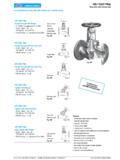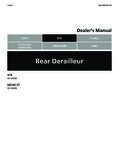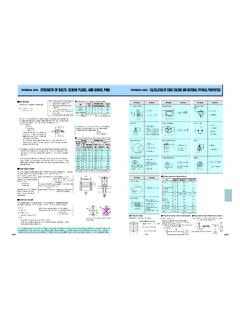Transcription of 4. Manufacturing screws and nuts
1 1017734. Manufacturing screws and Manufacturing processesIn principle, the following Manufacturing processes are differentiated:On the one hand there is forming without cutting and on the other, machining. With forming without cutting there is a further differentiation between cold and hot forming. The following diagram is intended to make the production processes clearer:Fig. N: Overview of the various production Cold forming (cold extrusion)In modern fastening technology the majority of fasten-ers are made using the cold forming procedure. In this procedure, the fastener is formed, usually in multistage processes, by pressure forging, cold extrusion and reduc-ing, or a combination of these procedures.
2 The term solid or cold forming was coined for this type of procedure is usually used for large quantities, because, from an economic aspect, it is the most rational method. The choice of the suitable forming machine depends on the size of the fastener and on the degree of forming. The greater the degree of forming, the more forming stages are required. Sharp-edged transitions or thin profiles are unfavourable for cold forming and lead to increased tool wear. A decisive role for the quality of the final product is played by the choice and the quality of the input material (wire).
3 Screw manufacturers usually receive the wire coiled on rolls that often weigh over 1000 kg. The wire is normally phosphate treated to enable the wire to be worked perfectly and to minimise tool wear. The designer of a screw or a fastener tries during develop-ment to harmonise the advantages and disadvantages of the different materials with the requirements specified for the fastener. With the materials differences are made, along with corrosion-resistant steels, between unalloyed and alloyed steels. For example, if increased strengths are required, it is absolutely essential to subject the parts after pressing to a heat treatment process in order to be able to influence the mechanical properties of the stages for a hexagon head screwNuts are usually produced with the cold or hot forming procedure as well.
4 The choice of one or the other proce-dure depends on the one hand on the size and on the other on the required IntermediateupsettingFinishingCalibratin gRound dieth re ad rollingAll information is provided without guarantee or claim to of the stages for a hexagonal nutAdvantages of cold forming:Optimal use of material Very high output High dimensional accuracy and surface quality Increase of strength properties through strain hardening Run of the chamfers in press parts in accordance with the Hot forming This production method is used mainly to manufacture large diameters starting with approx.
5 M27, and longer pieces starting from approx. 300 mm. In addition, parts are possible that cannot be produced using cold forming because of the very small volumes, or because of a very high degree of forming. With this procedure, the input material (usually bars) is heated wholly or partially to forging temperature. This heating up enables even complicated geometries or very high degrees of forming to be realised. A typical feature for a hot-formed component is the raw surface structure. Strain hardening is not carried out during hot forming!Advantages of hot forming: Enables production of complicated geometries Low production runs Large diameters and lengths Machining Machining is usually understood as processing steps such as turning, milling, grinding or reaming.
6 The most common method with regard to fasteners is turning, but this has lost a great deal of importance because of the technical possibilities of cold pressing. During turning, the required contour of the component is cut from the input material using a turning tool. The diameter of the input material depends on the largest diameter of the component. Usually, bars with a length of up to 6 m are used. In contrast to cold or hot forming, the chamfer course of the input material is destroyed. This production procedure is used either if the production run is not very large or if the part geometry cannot be complied with in cold or hot forming procedures because of sharp edges, small radiuses or even nominal sizes.
7 Surface roughnesses of Ra or Rz can be achieved with this production procedure without any problems. In the case of large production runs the blanks are often produced with the cold extrusion method and are then Thread production Where screws are mass-produced, the thread is usually formed or rolled. In this procedure, the screw is rolled between two rolling dies (flat dies), one of which is fixed and the other running, and this creates the thread (see the diagram). With this type of thread production it is possible to fit several hundred screws per minute with a thread.
8 The thread is usually applied before hardening and tempering. If special requirements mean that the thread is applied after the heat treatment process, the thread is referred to as finally rolled .All information is provided without guarantee or claim to methods for making threads:Plunge cuttingTool rolls that are driven at the same speed rotate in the same direction. The workpiece rotates without being axi-ally displaced. This method can be used to make threads with very high pitch methodThe thread pitch is generated by inclining the roller axes by the pitch angle. The workpiece is given an axial thrust and moves by one thread pitch in an axial direction, with a full rotation.
9 Overlength threads can be made in this cuttingIn this procedure the thread is made by means of a tap or a screw stock. With screws , this procedure is mainly used for very low production runs or with machined parts as , things are different when a female thread is made. In this case the thread is usually cut with a screw tap or taper cutting on an automatic lathe with a taper Fibre patternThe two diagrams show very clearly the differences between a rolled and a cut thread. With thread forming the material is work hardened again in addition, and the fibre pattern is not interrupted.
10 In this case, the original diameter of the screw is approximately the same as the flank diameter. With thread cutting, the original diameter of the screw is the same as the nominal diameter of the thread. The fibre pattern is interrupted by the Heat Hardening and temperingThe combination hardening and subsequent tempering is referred to as hardening and tempering. DIN EN ISO 898 Part 1 prescribes hardening and tempering for screws from strength class , and DIN EN 20898 Part 2 prescribes it for nuts in strength class 05 and 8 (>M16), and from strength class HardeningThe screw is heated to a specific temperature among other things in dependence on its carbon content and kept at this temperature for a long period.





